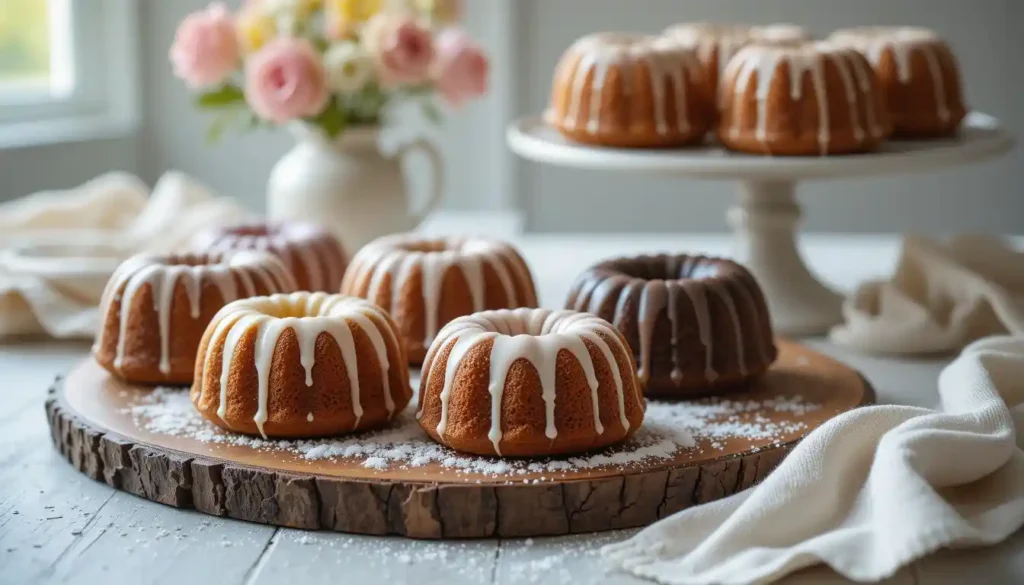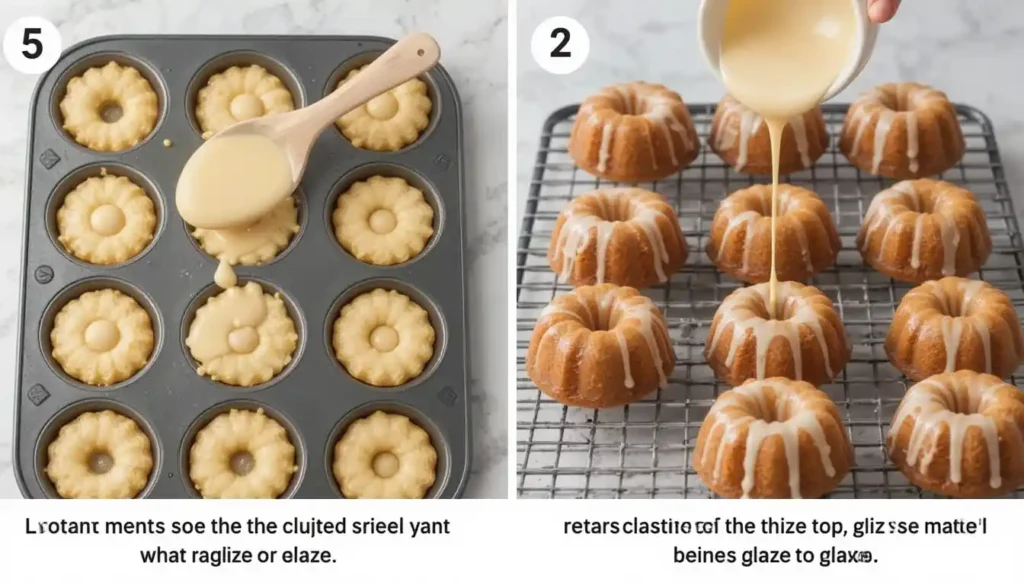Table of Contents
Portable, elegant, and endlessly customizable—individual desserts are reshaping how America entertains. Perfectly portioned creations offer all the charm of traditional baking without the hassle of slicing or wasted leftovers. The secret? A specialized pan design that creates uniform shapes while locking in moisture.
Mastering these treats requires precision. Too much flour creates dryness, while overmixing leads to dense textures. Room-temperature ingredients blend smoothly, and a 1:1 butter-to-sugar ratio ensures rich flavor. A dash of vanilla extract or citrus zest elevates simplicity into something extraordinary.
Creative finishes transform each serving into edible art. Drizzles of glossy ganache, tangy fruit glazes, or dustings of powdered sugar add personality. For best results, grease every crevice of your pan thoroughly—nobody wants a masterpiece stuck in its mold!

Ready to explore flavor combinations? From classic vanilla to espresso-infused batters, these recipes adapt to any taste. Grab your paddle attachment and let’s create desserts that delight both eyes and appetites.
Baking Fundamentals for Perfect Mini Bundt Cakes
Great bakers know: flawless results begin with foundational techniques. Whether you’re a weekend baker or a seasoned pro, mastering these principles ensures your creations rise evenly and release cleanly every time.
Essential Ingredients and Tools
Start with premium butter and fresh leavening agents—they’re non-negotiables for tender textures. A stand mixer with a paddle attachment creates airy batter faster than hand mixing. For consistent results:

- Measure flour using the spoon-and-level method to avoid compaction
- Grease every ridge of your specialty pan with baking spray
- Use pure vanilla or citrus zest for nuanced flavor layers
Temperature and Mixing Tips
Cold ingredients cause clumpy batter. Let eggs and dairy sit out for 30 minutes before blending. Cream softened butter and sugar until pale and fluffy—this traps air for lift. “Fold dry ingredients gently to preserve that precious aeration,” advises pastry chef Elena Martinez.
Always preheat your oven. A steady 350°F heat prevents uneven baking. Test doneness with a toothpick: crumbs should cling slightly for moist results. Cool in the pan just 10 minutes before transferring to a rack—this prevents sogginess while maintaining structural integrity.
Quick Guide to “mini bundt cake recipes” for Every Baker
Ready to create charming individual desserts? These petite treats combine simplicity with professional results when you follow methodical preparation. Let’s walk through the essentials for first-timers.

Step-by-Step Instructions for Beginners
Start by preheating your oven to 350°F. This ensures even heat distribution from the first minute. Lightly coat every groove of your specialty pan with nonstick spray—a pastry brush helps reach tight corners.
In a large bowl, blend softened butter and sugar until fluffy. Add eggs one at a time, mixing thoroughly after each. Stir in room-temperature sour cream and vanilla extract for moisture-rich batter. “Cold ingredients create lumps,” warns baker Jamie Lowell. Sift dry ingredients like flour and baking powder separately before folding them into the wet mixture.
Use a cookie scoop to fill cavities ¾ full—overfilling causes uneven domes. Bake 18-22 minutes until edges turn golden. Test with a toothpick: moist crumbs mean perfect doneness. Cool in the pan 10 minutes, then invert onto a wire rack. This prevents sticking while preserving delicate shapes.
Follow these steps, and you’ll master portion-controlled desserts that impress guests without stress. Happy baking!
Creative Twists and Flavor Variations
Unlock endless possibilities by reimagining classic designs with bold new flavors and textures. A few smart tweaks can turn familiar treats into conversation-starting showpieces.
Unique Glaze and Icing Ideas
Transform simple desserts with vibrant finishes. Try a red wine chocolate ganache for sophisticated depth or whipped mascarpone icing with lemon zest for brightness. Coffee glaze pairs perfectly with cinnamon-spiced batter, while raspberry icing adds fruity tang.
| Glaze Type | Best Pairings | Prep Time |
|---|---|---|
| Cream Cheese | Carrot or Spice | 5 minutes |
| Citrus Zest | Vanilla or Almond | 3 minutes |
| Berry Coulis | White Chocolate | 8 minutes |
Flavor Combinations and Add-ins
Swap vanilla extract for almond or coconut to create new taste profiles. Fold fresh blueberries into batter or layer citrus curd between pours. For holiday gatherings, mix crushed peppermint into white chocolate batter.
Pan Selection and Preparation Tips
Nonstick pans like Nordic Ware’s Bundtlette ensure clean releases. Use a pastry brush to apply melted butter into every crevice. “A well-prepped pan is the difference between flawless shapes and broken edges,” notes baker Simone Rhodes. Let desserts cool 8-10 minutes before inverting.
Experiment freely, but remember: room-temperature ingredients blend smoothly, and proper greasing prevents sticking. With these techniques, your creations will taste as stunning as they look!
Conclusion
The journey from batter to beautiful dessert is simpler than you think. By focusing on proper measurements and room-temperature ingredients, anyone can achieve tender textures and consistent results. A well-prepped pan and gentle mixing technique become your secret weapons against sticking or dryness.
These treats shine through customization. Swirl in citrus zest, drizzle with espresso glaze, or fold berries into the batter each variation tells its own story. They’re equally at home on brunch tables or dessert buffets, proving good things truly come in small packages.
New bakers often surprise themselves with professional-quality outcomes using trusted methods from brands like Nordic Ware. The real magic? Sharing your creations. Snap photos of that perfect crumb or innovative flavor twist your kitchen wins deserve an audience.
Grab your favorite mixing bowl and preheat the oven. With these fundamentals, every batch becomes a chance to craft edible joy. Happy baking!
FAQ
What tools do I need to make these small desserts?
You’ll need a stand mixer or hand mixer, a nonstick pan designed for individual servings, and basic baking tools like measuring cups. A silicone brush for greasing and a cooling rack are also helpful.
How do I prevent my desserts from sticking to the pan?
Generously coat the pan with butter or baking spray, making sure to reach all crevices. Dusting with flour after greasing adds an extra layer of protection for easy release.
Can I customize flavors for different occasions?
Absolutely! Add citrus zest, spices like cinnamon, or mix-ins like chocolate chips. Experiment with glazes try maple, espresso, or berry-infused options for a unique finish.
What’s the ideal oven temperature for even baking?
Preheat to 350°F (175°C). This ensures the batter rises evenly without over-browning. Use an oven thermometer to verify accuracy if your appliance runs hot or cold.
How long should I let the baked goods cool before removing them?
Allow 10–15 minutes for the structure to set. Inverting the pan too soon can cause breakage, while waiting too long might lead to sticking.
Can I use a regular-sized pan instead of specialty bakeware?
For best results, use the recommended pan size. Smaller cavities ensure proper heat distribution and cooking time, which larger pans can’t replicate.


1 thought on “mini bundt cake recipes”
Comments are closed.